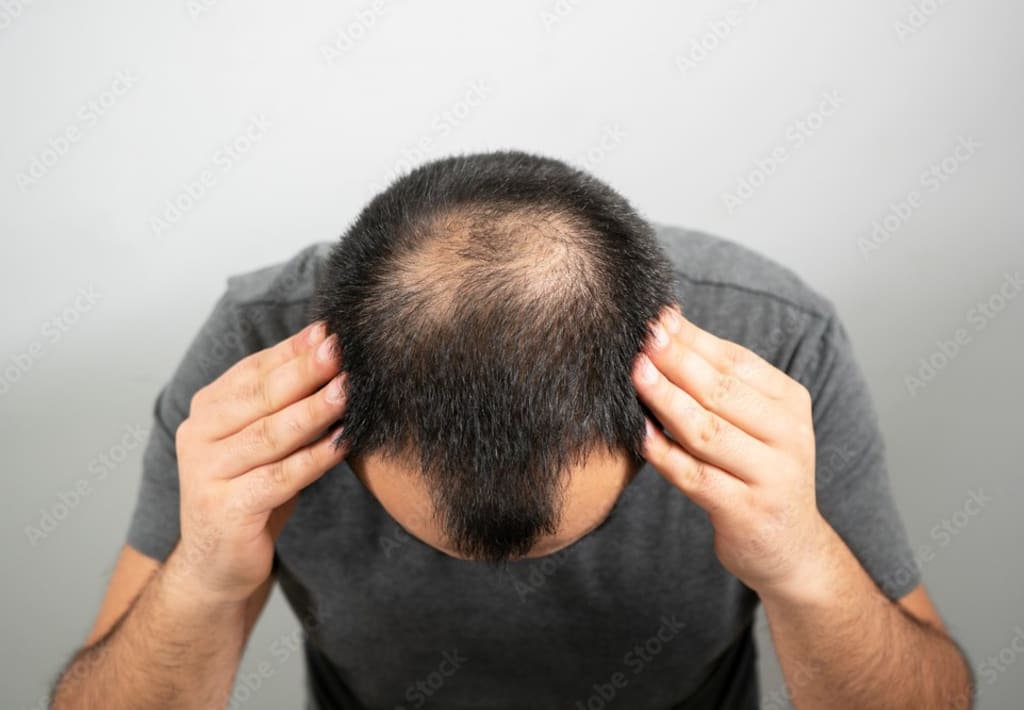What Causes Male Pattern Baldness: Understanding Hair Loss in Men
Hair Loss in Men

In this article, I am going to spell out exactly what causes male pattern baldness. So strap yourself in because things are gonna get hairy!
Table of Contents
1. Introduction: Male Pattern Baldness
2. The Pattern of Balding
3. Understanding Androgenetic Alopecia
4. Different Forms of Hair Loss
5. The Role of Genetics
6. Hair Growth Phases
7. The Influence of DHT
8. Debunking Myths About Hair Loss
9. Prevalence and Onset of Balding
10. Embracing Baldness
11. Psychological Impact of Hair Loss
12. Available Hair Loss Treatments
13. Conclusion
14. FAQs
1. Introduction: Male Pattern Baldness
Male pattern baldness, also known as androgenetic alopecia, is a common condition that affects a significant number of men. It is characterized by a distinct pattern of hair loss, which typically starts with a receding hairline and thinning hair on the crown of the head.
2. The Pattern of Balding
Male pattern baldness follows a specific pattern of hair loss. In most cases, the first signs appear at the temples, with the hairline gradually receding. Simultaneously, hair on the crown starts to thin, leading to the formation of bald patches. Eventually, these bald patches meet in the middle, resulting in complete baldness on the top of the scalp. However, the hair on the sides and back of the head, commonly referred to as the "rim of hair," usually remains intact.
3. Understanding Androgenetic Alopecia
Androgenetic alopecia is the medical term for male pattern baldness. It is predominantly caused by genetic factors and the influence of hormones like testosterone. While other forms of hair loss exist, they have distinct patterns and causes. Identifying the specific pattern of hair loss can help doctors make an accurate diagnosis.
4. Different Forms of Hair Loss
Apart from androgenetic alopecia, there are other forms of hair loss with different patterns. Iron deficiency, for example, can lead to general thinning of hair all over the scalp. Some types of hair loss may only affect a specific part of the scalp. Consulting a family doctor or dermatologist is essential for an accurate diagnosis based on the pattern of hair loss.
5. The Role of Genetics
Male pattern baldness is primarily a genetic condition. Studies comparing identical and non-identical twins have shown that genetics contribute to approximately 81 percent of male pattern hair loss. Multiple genes inherited from both the mother and father's side can play a role in hair loss, making it a complex condition influenced by various genetic factors.
6. Hair Growth Phases
Understanding the normal hair growth cycle is crucial to comprehend male pattern baldness. Hair growth occurs in distinct phases. The first phase is the growth phase, during which hair follicles produce chains of keratin, a hard protein. This phase can last anywhere from two to six years and results in thick hair. After the growth phase, the hair enters a resting phase for approximately three months before falling out. Subsequently, the growth cycle begins again.
7. The Influence of DHT
For individuals with a genetic predisposition to male pattern hair loss, their hair follicles are particularly sensitive to dihydrotestosterone (DHT), a derivative of testosterone. DHT shortens the growth phase of certain hair follicles, leading to shorter and thinner hairs. This sensitivity to DHT affects specific parts of the scalp more than others, resulting in the characteristic pattern of hair loss associated with male pattern baldness.
8. Debunking Myths About Hair Loss
There are several myths surrounding male pattern baldness that need to be debunked. One common myth is that balding men have higher testosterone levels than non-balding men, but in reality, testosterone levels are similar in both groups. The key difference lies in the conversion of testosterone to DHT and the sensitivity of hair follicles to DHT. Another myth suggests that sexual activity or frequent sex leads to hair loss, which is untrue. However, the use of performance-enhancing drugs like anabolic steroids and testosterone can increase the risk of hair loss due to their impact on androgen hormones.
9. Prevalence and Onset of Balding
Male pattern baldness is highly prevalent, with approximately 1 in 2 adult men in their 40s experiencing noticeable levels of balding. Most men will experience some degree of baldness during their lifetime, but the rate and extent of hair loss can vary significantly. Some men may start losing hair as early as their 20s, while others may maintain their hair well into their 60s. Notably, male pattern baldness becomes noticeable only after approximately half of the hair follicles have already been affected, indicating that early intervention is crucial.
10. Embracing Baldness
While male pattern baldness may be distressing for some individuals, it is essential to recognize that it is a natural part of the aging process. Many men embrace their baldness and adopt fuss-free hair routines. However, others may feel embarrassed or self-conscious about their hair loss. The psychological impact of hair loss can range from feelings of unattractiveness to depression.
11. Psychological Impact of Hair Loss
Hair loss can have significant psychological consequences, affecting an individual's self-esteem and overall well-being. Society's emphasis on a full head of hair as a symbol of youth and attractiveness can exacerbate these feelings. It is essential to address the emotional aspects of hair loss and seek support when needed.
12. Available Hair Loss Treatments
Fortunately, various treatments are available for individuals bothered by their hair loss. Early intervention is crucial for the best outcomes. There are different approaches to treating male pattern baldness, including medications, topical treatments, hair transplantation, and low-level laser therapy. Consulting a healthcare professional or a hair loss specialist can provide personalized recommendations based on individual needs and preferences.
13. Conclusion
Male pattern baldness, or androgenetic alopecia, is a common condition characterized by a specific pattern of hair loss. It is primarily influenced by genetics and the sensitivity of hair follicles to dihydrotestosterone (DHT). While balding is a natural part of the aging process for many men, it can have psychological implications for some individuals. Seeking early treatment and support can help manage the emotional impact and explore available options for hair loss treatments.
14. FAQs
1. Is male pattern baldness reversible?
Male pattern baldness is generally not reversible, but certain treatments can slow down or halt further hair loss and, in some cases, promote hair regrowth.
2. Are there any natural remedies for male pattern baldness?
While natural remedies may have limited scientific evidence, some people claim that certain herbs, oils, and dietary supplements can help with hair growth. It's important to consult with a healthcare professional before trying any alternative treatments.
3. Are there any side effects of hair loss medications?
Some medications used to treat male pattern baldness may have side effects such as sexual dysfunction, scalp irritation, or unwanted hair growth in other
About the Creator
Tajamul Hassan
An accomplished professional in the field of Management Sciences, Nutrition, and Health and Fitness. Over a decade of extensive experience in development as well in Health Sector. Dedicated to improving people's lives.
Enjoyed the story? Support the Creator.
Subscribe for free to receive all their stories in your feed. You could also pledge your support or give them a one-off tip, letting them know you appreciate their work.






Comments
There are no comments for this story
Be the first to respond and start the conversation.